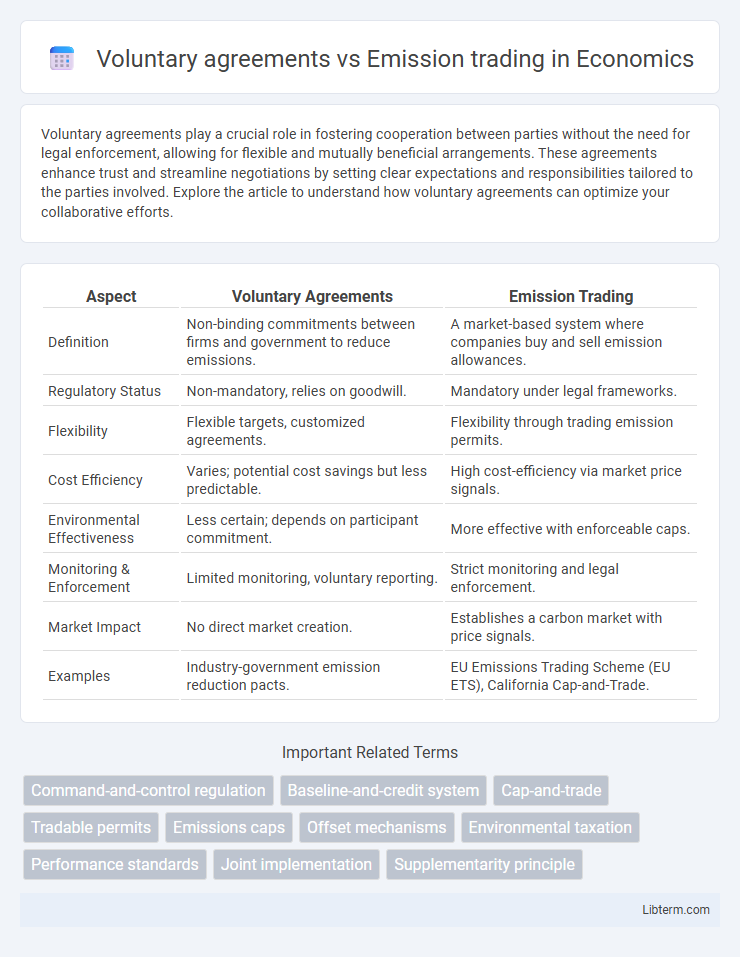Voluntary agreements play a crucial role in fostering cooperation between parties without the need for legal enforcement, allowing for flexible and mutually beneficial arrangements. These agreements enhance trust and streamline negotiations by setting clear expectations and responsibilities tailored to the parties involved. Explore the article to understand how voluntary agreements can optimize your collaborative efforts.
Table of Comparison
| Aspect | Voluntary Agreements | Emission Trading |
|---|---|---|
| Definition | Non-binding commitments between firms and government to reduce emissions. | A market-based system where companies buy and sell emission allowances. |
| Regulatory Status | Non-mandatory, relies on goodwill. | Mandatory under legal frameworks. |
| Flexibility | Flexible targets, customized agreements. | Flexibility through trading emission permits. |
| Cost Efficiency | Varies; potential cost savings but less predictable. | High cost-efficiency via market price signals. |
| Environmental Effectiveness | Less certain; depends on participant commitment. | More effective with enforceable caps. |
| Monitoring & Enforcement | Limited monitoring, voluntary reporting. | Strict monitoring and legal enforcement. |
| Market Impact | No direct market creation. | Establishes a carbon market with price signals. |
| Examples | Industry-government emission reduction pacts. | EU Emissions Trading Scheme (EU ETS), California Cap-and-Trade. |
Introduction to Market-Based Environmental Policies
Voluntary agreements allow firms to commit to environmental targets without regulatory enforcement, fostering flexible, cooperative approaches to pollution reduction. Emission trading systems establish a market for buying and selling pollution permits, creating financial incentives to lower emissions efficiently. Both policies harness market forces to achieve environmental goals, but emission trading provides a quantifiable cap on emissions, whereas voluntary agreements rely on negotiated commitments.
Defining Voluntary Agreements
Voluntary agreements are collaborative commitments made between governments and industries to reduce emissions without legally binding targets, promoting flexibility and cost-effectiveness. These agreements often include specific emission reduction goals, monitoring mechanisms, and reporting requirements, aiming to encourage proactive environmental responsibility. Unlike emission trading systems, which allocate tradable permits and establish a market-based cap on emissions, voluntary agreements rely on negotiated cooperation and mutual trust.
Understanding Emission Trading Systems
Emission Trading Systems (ETS) create a market-driven approach allowing companies to buy and sell emission allowances, promoting cost-effective carbon reduction by setting a cap on total emissions. Voluntary agreements depend on negotiated commitments between governments and businesses without binding limits, often lacking the economic incentives seen in ETS. Understanding ETS reveals how fixed emission caps and tradable permits drive innovation and compliance, contrasting with the flexibility but limited enforcement in voluntary schemes.
Key Differences between Voluntary Agreements and Emission Trading
Voluntary agreements are non-binding commitments where companies set their own emission reduction targets, promoting flexibility and cooperation without legal enforcement, while emission trading involves a regulated market system where companies buy and sell emission allowances under legally binding caps. Emission trading provides a clear carbon price signal that incentivizes cost-effective reductions, whereas voluntary agreements rely on intrinsic motivation and reputational benefits without guaranteed outcomes. The key difference lies in the enforcement mechanism and market-based incentives present in emission trading, contrasting with the collaborative, unilateral nature of voluntary agreements.
Environmental Effectiveness: Comparing Outcomes
Voluntary agreements often result in variable environmental effectiveness due to their non-binding nature, leading to inconsistent emission reductions across industries. Emission trading systems (ETS) provide a market-based approach with clear caps on total emissions, ensuring more predictable and enforceable outcomes in reducing greenhouse gases. Empirical studies show ETS frameworks typically achieve greater overall emission declines compared to voluntary agreements by incentivizing cost-efficient pollution control.
Cost-Effectiveness and Economic Implications
Voluntary agreements often entail negotiated commitments between governments and firms that can lower compliance costs but may lack market-driven efficiency found in emission trading systems. Emission trading leverages market-based mechanisms to allocate pollution permits, promoting cost-effectiveness by enabling firms with lower abatement costs to sell excess allowances to higher-cost firms. Economically, emission trading creates financial incentives for innovation and emissions reduction, whereas voluntary agreements may result in varied commitment levels and limited scalability in addressing large-scale environmental externalities.
Industry Participation and Stakeholder Engagement
Voluntary agreements often see higher industry participation as companies willingly commit to environmental targets, fostering collaborative stakeholder engagement through transparent goal-setting and regular reporting. Emission trading systems engage industries via regulatory mandates, allowing market-driven flexibility but sometimes limiting proactive stakeholder collaboration to compliance activities. Effective stakeholder engagement in voluntary agreements typically enhances trust and innovation, while emission trading emphasizes cost-efficiency and compliance-driven interaction.
Regulatory Flexibility and Compliance Incentives
Voluntary agreements offer regulatory flexibility by allowing firms to set self-determined emission reduction targets, fostering customized strategies that align with corporate capabilities and market conditions. Emission trading systems create compliance incentives through market-based mechanisms, enabling companies to buy and sell emission allowances, thus promoting cost-effective pollution control and real-time adjustments to regulatory requirements. While voluntary agreements depend on cooperative commitment and may lack enforceability, emission trading combines flexibility with binding compliance, driving measurable environmental outcomes.
Real-World Case Studies and Lessons Learned
Voluntary agreements in environmental policy, exemplified by the U.S. Climate Challenge Program, often depend on corporate goodwill and demonstrate mixed effectiveness in reducing emissions without regulatory enforcement. Emission trading systems like the European Union Emission Trading Scheme (EU ETS) provide a market-based approach, enabling cost-effective emission reductions by setting a cap and allowing tradable permits, which have proven successful in cutting greenhouse gases across power and industrial sectors. Lessons learned emphasize that emission trading delivers measurable environmental outcomes with economic incentives, whereas voluntary agreements require robust monitoring and verification to prevent underachievement and ensure genuine climate benefits.
Future Prospects and Policy Recommendations
Voluntary agreements offer flexibility and encourage early emission reductions but lack enforceability compared to emission trading systems, which provide market-based incentives and clearer regulatory frameworks. Future prospects favor integrating voluntary agreements with cap-and-trade mechanisms to enhance participation while maintaining stringent emission caps. Policy recommendations emphasize designing hybrid models that leverage the strengths of both approaches, ensuring transparency, robust monitoring, and aligning incentives with long-term climate targets.
Voluntary agreements Infographic

 libterm.com
libterm.com